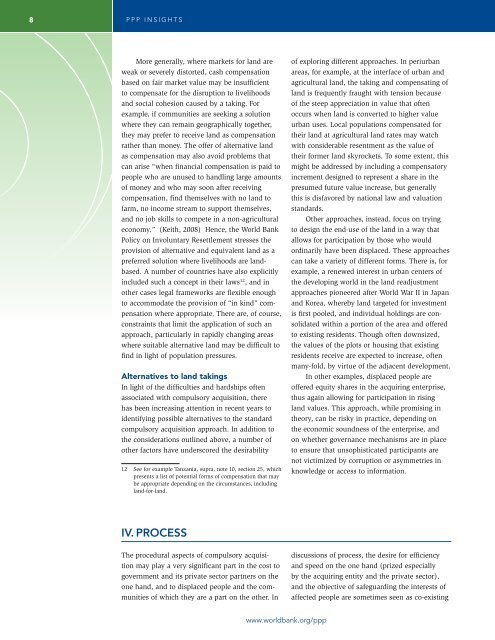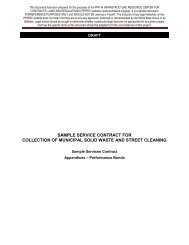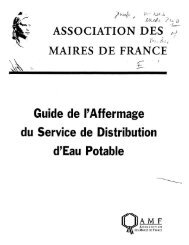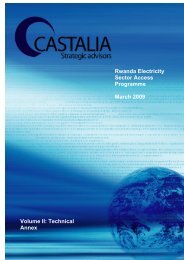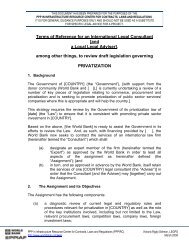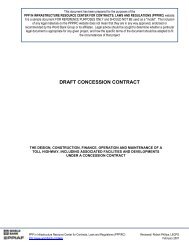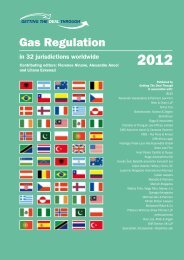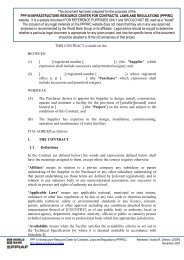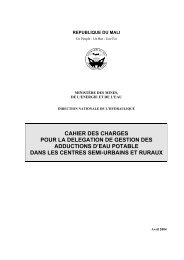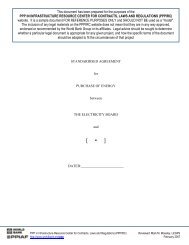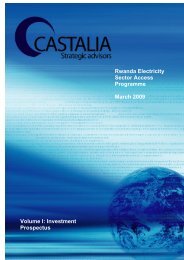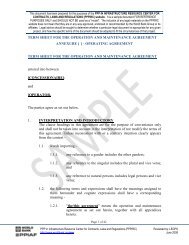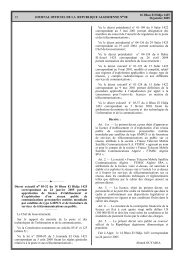Compulsory Acquisition of Land and Compensation in Infrastructure ...
Compulsory Acquisition of Land and Compensation in Infrastructure ...
Compulsory Acquisition of Land and Compensation in Infrastructure ...
Create successful ePaper yourself
Turn your PDF publications into a flip-book with our unique Google optimized e-Paper software.
8 PPP Insights<br />
More generally, where markets for l<strong>and</strong> are<br />
weak or severely distorted, cash compensation<br />
based on fair market value may be <strong>in</strong>sufficient<br />
to compensate for the disruption to livelihoods<br />
<strong>and</strong> social cohesion caused by a tak<strong>in</strong>g. For<br />
example, if communities are seek<strong>in</strong>g a solution<br />
where they can rema<strong>in</strong> geographically together,<br />
they may prefer to receive l<strong>and</strong> as compensation<br />
rather than money. The <strong>of</strong>fer <strong>of</strong> alternative l<strong>and</strong><br />
as compensation may also avoid problems that<br />
can arise “when f<strong>in</strong>ancial compensation is paid to<br />
people who are unused to h<strong>and</strong>l<strong>in</strong>g large amounts<br />
<strong>of</strong> money <strong>and</strong> who may soon after receiv<strong>in</strong>g<br />
compensation, f<strong>in</strong>d themselves with no l<strong>and</strong> to<br />
farm, no <strong>in</strong>come stream to support themselves,<br />
<strong>and</strong> no job skills to compete <strong>in</strong> a non-agricultural<br />
economy.” (Keith, 2008) Hence, the World Bank<br />
Policy on Involuntary Resettlement stresses the<br />
provision <strong>of</strong> alternative <strong>and</strong> equivalent l<strong>and</strong> as a<br />
preferred solution where livelihoods are l<strong>and</strong>based.<br />
A number <strong>of</strong> countries have also explicitly<br />
<strong>in</strong>cluded such a concept <strong>in</strong> their laws 12 , <strong>and</strong> <strong>in</strong><br />
other cases legal frameworks are flexible enough<br />
to accommodate the provision <strong>of</strong> “<strong>in</strong> k<strong>in</strong>d” compensation<br />
where appropriate. There are, <strong>of</strong> course,<br />
constra<strong>in</strong>ts that limit the application <strong>of</strong> such an<br />
approach, particularly <strong>in</strong> rapidly chang<strong>in</strong>g areas<br />
where suitable alternative l<strong>and</strong> may be difficult to<br />
f<strong>in</strong>d <strong>in</strong> light <strong>of</strong> population pressures.<br />
Alternatives to l<strong>and</strong> tak<strong>in</strong>gs<br />
In light <strong>of</strong> the difficulties <strong>and</strong> hardships <strong>of</strong>ten<br />
associated with compulsory acquisition, there<br />
has been <strong>in</strong>creas<strong>in</strong>g attention <strong>in</strong> recent years to<br />
identify<strong>in</strong>g possible alternatives to the st<strong>and</strong>ard<br />
compulsory acquisition approach. In addition to<br />
the considerations outl<strong>in</strong>ed above, a number <strong>of</strong><br />
other factors have underscored the desirability<br />
12 See for example Tanzania, supra, note 10, section 25, which<br />
presents a list <strong>of</strong> potential forms <strong>of</strong> compensation that may<br />
be appropriate depend<strong>in</strong>g on the circumstances, <strong>in</strong>clud<strong>in</strong>g<br />
l<strong>and</strong>-for-l<strong>and</strong>.<br />
<strong>of</strong> explor<strong>in</strong>g different approaches. In periurban<br />
areas, for example, at the <strong>in</strong>terface <strong>of</strong> urban <strong>and</strong><br />
agricultural l<strong>and</strong>, the tak<strong>in</strong>g <strong>and</strong> compensat<strong>in</strong>g <strong>of</strong><br />
l<strong>and</strong> is frequently fraught with tension because<br />
<strong>of</strong> the steep appreciation <strong>in</strong> value that <strong>of</strong>ten<br />
occurs when l<strong>and</strong> is converted to higher value<br />
urban uses. Local populations compensated for<br />
their l<strong>and</strong> at agricultural l<strong>and</strong> rates may watch<br />
with considerable resentment as the value <strong>of</strong><br />
their former l<strong>and</strong> skyrockets. To some extent, this<br />
might be addressed by <strong>in</strong>clud<strong>in</strong>g a compensatory<br />
<strong>in</strong>crement designed to represent a share <strong>in</strong> the<br />
presumed future value <strong>in</strong>crease, but generally<br />
this is disfavored by national law <strong>and</strong> valuation<br />
st<strong>and</strong>ards.<br />
Other approaches, <strong>in</strong>stead, focus on try<strong>in</strong>g<br />
to design the end-use <strong>of</strong> the l<strong>and</strong> <strong>in</strong> a way that<br />
allows for participation by those who would<br />
ord<strong>in</strong>arily have been displaced. These approaches<br />
can take a variety <strong>of</strong> different forms. There is, for<br />
example, a renewed <strong>in</strong>terest <strong>in</strong> urban centers <strong>of</strong><br />
the develop<strong>in</strong>g world <strong>in</strong> the l<strong>and</strong> readjustment<br />
approaches pioneered after World War II <strong>in</strong> Japan<br />
<strong>and</strong> Korea, whereby l<strong>and</strong> targeted for <strong>in</strong>vestment<br />
is first pooled, <strong>and</strong> <strong>in</strong>dividual hold<strong>in</strong>gs are consolidated<br />
with<strong>in</strong> a portion <strong>of</strong> the area <strong>and</strong> <strong>of</strong>fered<br />
to exist<strong>in</strong>g residents. Though <strong>of</strong>ten downsized,<br />
the values <strong>of</strong> the plots or hous<strong>in</strong>g that exist<strong>in</strong>g<br />
residents receive are expected to <strong>in</strong>crease, <strong>of</strong>ten<br />
many-fold, by virtue <strong>of</strong> the adjacent development.<br />
In other examples, displaced people are<br />
<strong>of</strong>fered equity shares <strong>in</strong> the acquir<strong>in</strong>g enterprise,<br />
thus aga<strong>in</strong> allow<strong>in</strong>g for participation <strong>in</strong> ris<strong>in</strong>g<br />
l<strong>and</strong> values. This approach, while promis<strong>in</strong>g <strong>in</strong><br />
theory, can be risky <strong>in</strong> practice, depend<strong>in</strong>g on<br />
the economic soundness <strong>of</strong> the enterprise, <strong>and</strong><br />
on whether governance mechanisms are <strong>in</strong> place<br />
to ensure that unsophisticated participants are<br />
not victimized by corruption or asymmetries <strong>in</strong><br />
knowledge or access to <strong>in</strong>formation.<br />
IV. PROCESS<br />
The procedural aspects <strong>of</strong> compulsory acquisition<br />
may play a very significant part <strong>in</strong> the cost to<br />
government <strong>and</strong> its private sector partners on the<br />
one h<strong>and</strong>, <strong>and</strong> to displaced people <strong>and</strong> the communities<br />
<strong>of</strong> which they are a part on the other. In<br />
discussions <strong>of</strong> process, the desire for efficiency<br />
<strong>and</strong> speed on the one h<strong>and</strong> (prized especially<br />
by the acquir<strong>in</strong>g entity <strong>and</strong> the private sector),<br />
<strong>and</strong> the objective <strong>of</strong> safeguard<strong>in</strong>g the <strong>in</strong>terests <strong>of</strong><br />
affected people are sometimes seen as co-exist<strong>in</strong>g<br />
www.worldbank.org/ppp


